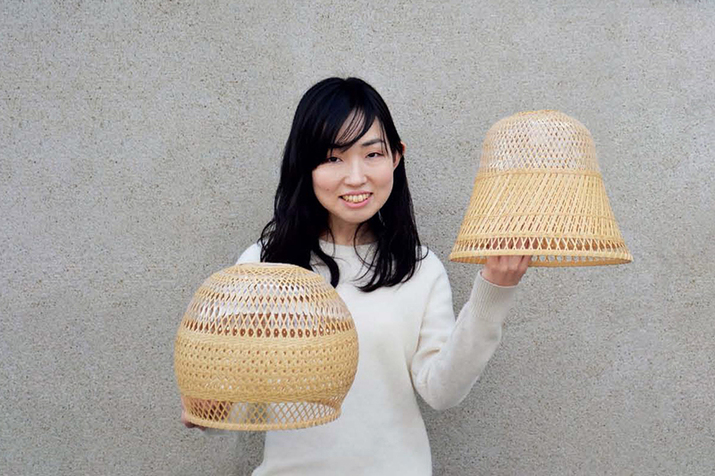
R
E
V N
E
X
T
Temperate Chimbarongo is known, colloquially, as the “wicker capital” of Chile. Everywhere you go, you might find bundles of natural fiber, ready to be woven into mimbre baskets or intricate wickerwork; women and men alike sit in small shops from sunrise to sunset, shaping the durable strands. This craft-dominant commune, and many other like it across the world, is a source of inspiration and collaboration for Alvaro Catalán de Ocón, award-winning founder of the PET lamp project and an environmental activist dedicated to pairing small communities with eco-friendly design.
After graduating from Central St. Martins in 2004 with a degree in product design, Ocón created La Flaca, a slim, minimalist standing lamp that reduces energy consumption. In 2011, he developed the first PET lamp, in which used plastic bottles are recycled as ceiling light shades—for this project, he solicits craftsmen from small communities across the globe, from Chile to Japan, to collaborate on different editions. In this way, he honors a commitment to “create an awareness and appreciation towards the value of crafts and the person behind the product you are buying, instead of simply the cold, industrial product.”
We speak to Ocón ahead of his participation at the MILL6 Foundation symposium on Dec 9–10, for which he will give the keynote lecture for TECHSTYLE Series 2.1: “Fabpublic! – Talking about Textile, Community and Public Space.”
The La Flaca lamps are simple and minimalist in comparison to the colorful and texture-heavy designs of PET lamps. What made you change your design concept in the early 2000s?
Yes, PET lamps have a very different look to the La Flaca or other past projects of mine, but, actually, the approach is very similar. My aim as a designer is to develop the simplest possible method for a product—with the PET lamp project, that was to transform a plastic bottle into a lampshade using local craftsmanship and then build the simplest or most transparent system to have them hanging in one single chandelier. I consider myself a reductionist; that’s why I don’t intervene in the artisans’ personal and traditional use of colors and designs.
Why plastic?
I was on holiday in Colombia and a friend raised the issue of plastic waste in the Amazon River. At the time, there were multiple studies regarding the plastic islands at the center of the oceans. We knew we couldn’t resolve the problem of plastic. However, in my belief, designers do not only create products but are also capable of communicating a message with them. I wanted to explore the great contradiction within plastic bottles. They have a very short life, but are made with a material that lasts for centuries.
The PET lamp project originally started as an awareness project. How has it developed from there?
The PET lamp project has the capacity to reinvent itself with every different edition due to the global abundance of traditional textile techniques. It is formed from the existence of two things: plastic waste, which is a big, worldwide problem; and the heritage of weaving. These two elements are found everywhere. Looking for the most ancient and pure weaving techniques is an anthropological journey guided by the craftsmen. They know better than anyone else the traditions, values or landscapes of where they live.
The inspiration behind the design for PET lamps is directly related to Japanese bamboo tea ceremony rituals and objects. How is that explored in the aesthetic of the lamps?
We traveled to Kyoto to approach bamboo artisans and study the material and techniques used to create a bamboo ceremony tea whisk. This object was the inspiration behind transforming the bottle into a lamp shade, by cutting the vessel into strips and creating a kind of loom which you could then weave onto. It’s not so much the aesthetic of the tea whisk that interested me but the way the material was used and manipulated to alter its original shape.
The way Kyoto bamboo artisans approach their craft is very different to any other I had seen before—maybe only comparable to the weavers we worked with in Australia. In Kyoto, craft is understood not just as a way of creating objects for everyday day use but as a form of expression. The Japanese have a name for simple product-making: mingei, which roughly translates as “art of the ordinary people.”
How will the PET lamp project continue to grow?
We have launched the product in five continents so far, which proves how global the project has become. At the same time, it is becoming more and more complicated to run. Still, it is such an enriching and inspiring project that we can’t say no to new opportunities. Our aim is to offer a PET lamp chandelier, where every single lamp comes from a different country and tells the story of an individual artisan as well as their traditional weaving techniques. This is why we decided to concentrate on just one type of product—the pendant lamp—instead of branching out into a variety of products.
In general, how can consumers ensure that they are purchasing a sustainable product? What should we all be aware of?
Consumers need to know how products are made, by whom and with what materials. At the end of the day, I’m more interested in the storytelling of the product, rather than in its real ecological impact. We are proud to have sold around 15,000 lamps. Those 15,000 bottles are not going to resolve the waste problem permanently or even significantly; however, there are now at least 15,000 people who understand the ecological problem of plastic bottles.
Alvaro Catalán de Ocón is one of the keynote speakers of TECHSTYLE Series 2.1: “Fabpublic! – Talking about Textile, Community and Public Space”symposium, taking place on December 9 and 10, at The Hong Kong Polytechnic University.










